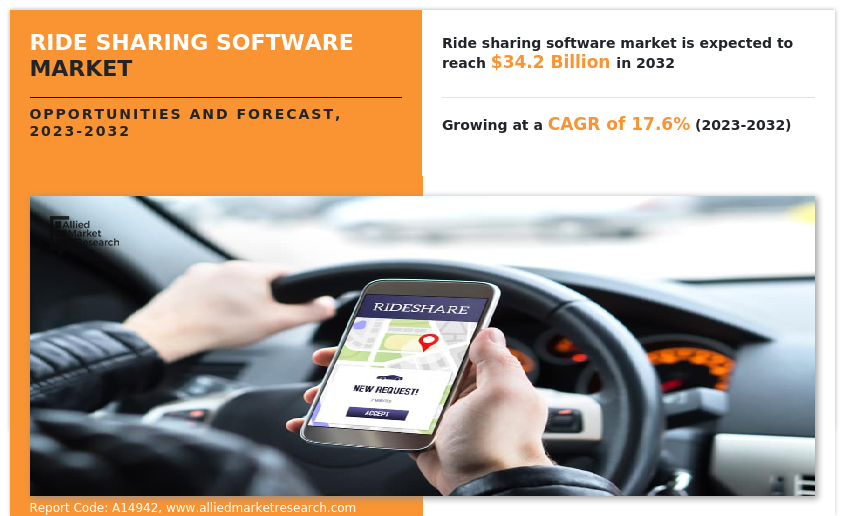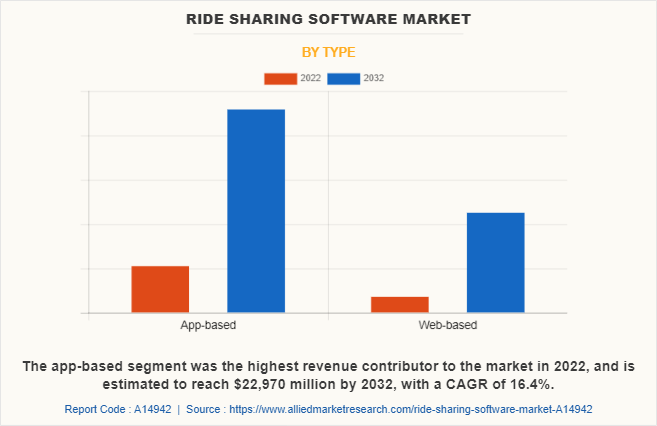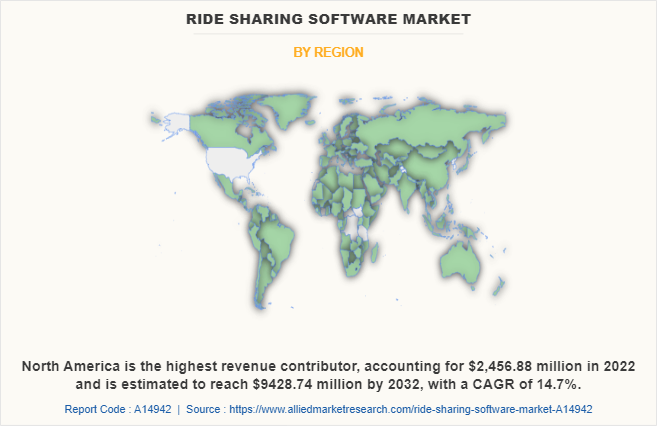Ride Sharing Software Market Statistics, 2032
The global ride sharing software market was valued at $7 billion in 2022, and is projected to reach $34.2 billion by 2032, growing at a CAGR of 17.6% from 2023 to 2032.
Ride sharing software refers to the technology platforms that connect individual drivers with passengers looking for share rides. This software or platform allows drivers to offer vacant seats in their vehicles to passengers traveling in the same direction. It consists of several operations such as searching for the appropriate ride, booking the ride, and payment options. In addition, this software can also be used for corporate transportation services, as many corporate offices manage their own internet ride sharing platforms for providing cab services to the employees.

The integration of advanced technologies such as internet of things has the potential to create several benefits for businesses and consumers alike. The ride sharing software can help to improve efficiency, as well as reduce costs for the particular ride. Moreover, it can provide enhanced convenience and a better user experience for consumers. In addition, the use of automation technology in conjunction with the IoT can help to improve data management and analytics, as well as provide businesses with a better understanding of their products. Such enhanced factors are expected to provide lucrative opportunities for market growth during the forecast period.
Factors such as surge in digitalization, rise in need for intelligent transportation systems, and increase in adoption of advanced technologies positively impact the growth of the market. In addition, the rise in adoption of IoT devices, advancements in smartphone technology, and upsurge in demand for automation are expected to fuel the growth of the market during the forecast period. Furthermore, the expansion of ride sharing software in various industries such as corporate, agriculture, and retail, is expected to provide lucrative growth opportunities for the market in the upcoming years. Moreover, the increase in expenses related to vehicle ownership and hyper-urbanization are the major drivers for the global ride sharing software growth, which is anticipated to create lucrative opportunities for market growth.
Moreover, the increase in penetration of smartphones & internet and the surge in demand for convenient transportation are expected to positively impact the growth of the market in the future. In addition, the increase in expenses of vehicle ownership propels global market growth. However, safety and security concerns are expected to hamper market growth. In addition, varying transport policies of different countries can deter small and medium-sized enterprises (SMEs) from adopting this technology. Furthermore, the rising integration of autonomous ride sharing creates numerous opportunities for ride sharing software to optimize the ride experience, reduce cost, and improve the quality of rides. Moreover, the integration of advanced mobility services is expected to offer remunerative opportunities for the expansion of the global market during the forecast period
Segment Review
The ride sharing software market is segmented into type, service type, and region. By type, it is bifurcated into web-based and app-based. By service type, it is divided into e-hailing, car sharing, and car rental. Region wise, it is analyzed across North America, Europe, Asia-Pacific, and LAMEA.

On the basis of type, the ride sharing software market share was dominated by the app-based segment in 2022 and is expected to maintain its dominance in the upcoming years, owing to advances in ride sharing services attributed to ease of bookings, passenger convenience, and comfort enabling the app-based services to transform the transport industries globally. However, the web-based segment is expected to witness the highest growth. An increase in network connectivity is expected to force organizations to adopt web-based services curated for the needs of organizations to provide effective transport services.

By region, North America dominated the market share in 2022 for the ride sharing software market. The increasing investment in advanced technologies such as cloud-based services and IoT to improve businesses and the consumer experience is anticipated to propel the growth of the ride sharing software market. However, Asia-Pacific is expected to exhibit the highest growth during the forecast period. This is attributed to the increase in penetration of digitalization and higher adoption of advanced technology is expected to provide lucrative growth opportunities for the market in this region.
Top Impacting Factors
Increase in Penetration of Smartphones and Internet:
The rise in trend of smartphones and internet in transport operations to improve optimization directly influences the growth of the global ride sharing software market. Radical advancements in the transport environment, enabled through communication technologies, require revising present business models and maintenance strategies. Consequently, ride sharing software has gained significant adoption to increase the use of IT and control systems among transport operators, particularly smartphone usage and other digital technologies.
In addition, increased use of smartphones and the internet helps consumers to easily access the ride sharing software, by simply downloading the ride sharing app on their phones. Such ease of access has contributed towards the high growth adoption of this software. These factors are likely to contribute to the increased installation of ride sharing software market, globally.
Furthermore, the integration of smartphones and the internet solution enables an effective user experience for ride sharing services. Consumers can easily locate the ride through an application, view available drivers and their estimated arrival times, track the progress of the ride in real time, and initiate cashless payments. In addition, the integration of automated systems in ride sharing software has reduced the rate of errors, such as traffic congestion, as well as operating costs. Hence, these multiple benefits offered by smartphones and internet use in transport operations and maintenance services are expected to boost the demand for ride sharing software market trends.
Moreover, public and private businesses are continuously involved in promoting digitalization in transport operations. For instance, in May 2023, Goldman Sachs raised $1 million in funding for the improvement of the ride-hailing app of Go Inc. Such investment pooling in the digitalizing of the transport system is expected to fuel the demand for ride sharing software market growth.
Growth in Demand for Convenient Transportation:
The increase in demand for convenient transportation options among consumers has encouraged businesses to expand ride sharing software and has impacted market growth. Several regional governments have made strategic investments in expanding convenient transport operations. This is due to the rising number of countries committing to reducing the stress added to ride-hailing applications caused by increased frequencies, and capacities.
Furthermore, government policies have undertaken increased initiatives to embrace advanced technology, with plans for integrating a new digital transport system to modernize traditional systems. For instance, in April 2022, Swiggy raised $180 million in funding for supporting Rapido, a bike taxi startup. Therefore, ride sharing software gained wider traction among end-users, taking advantage of advanced technologies by optimizing transport services.
Moreover, the ride sharing software allows the consumers to have a convenient approach to book the vehicle. With user-friendly mobile apps, consumers may request a ride with just a few taps on their smartphones. This eliminates the need to search for taxis or wait for public transportation, saving time and effort. In addition, ride-sharing services offer on-demand transportation, allowing consumers to request a ride whenever they need it. Such benefits encourage businesses to adopt ride sharing software to enhance their portfolio.
For instance, in November 2022, inDrive launched Set-your-own-price ride-hailing application. Through these services, it is enhancing the ride-sharing industry by allowing passengers and drivers to negotiate fair fares amongst themselves. Such advancements in transport operations is expected to eventually contribute to the growth of the global ride sharing software industry. .
Key Benefits for Stakeholders
- The study provides an in-depth ride sharing software market analysis along with the current trends and future estimations to elucidate the imminent investment pockets.
- Information about key drivers, restraints, and opportunities and their impact analysis on the ride sharing software market size is provided in the report.
- Porter’s five forces analysis illustrates the potency of buyers and suppliers operating in the ride sharing software industry.
- The quantitative analysis of the global ride sharing software market for the period 2022–2032 is provided to determine the ride sharing software market potential.
Ride Sharing Software Market Report Highlights
| Aspects | Details |
| Market Size By 2032 | USD 34.2 billion |
| Growth Rate | CAGR of 17.6% |
| Forecast period | 2022 - 2032 |
| Report Pages | 206 |
| By Type |
|
| By Service Type |
|
| By Region |
|
| Key Market Players | Ola Cabs, Zimride Inc. (Enterprise Holdings), BlaBlaCar, Gett, HyreCar Inc., Wingz, Via Transportation, Inc., Uber Technologies, Inc., Lyft, Inc., Didi Chuxing Technology Co |
Analyst Review
As the ride sharing software industry continues to evolve, CXOs are evaluating the opportunities and challenges regarding this emerging technology. The ride sharing software technology has grown rapidly in response to the increase in usage of smartphones & Internet of Things (IoT) devices and the need for cost-efficient transport services. CXOs consider the benefits that ride sharing software can offer, such as the ability to provide a unified and scalable solution for managing and processing the numerous transport operations in any smartphone device, enabling cost-effective mobility services. In addition, ride sharing software can help organizations optimize their operations, reduce costs, and improve consumer experience by automating the shared ride and providing personalized services. Such factors are expected to provide lucrative opportunities for market growth during the forecast period.
Furthermore, ride sharing software can enable innovation and collaboration by providing a user-friendly and modular architecture that allows drivers and customers to experience new applications and services. However, CXOs recognize the challenges associated with ride sharing software. One significant challenge is the industry's fragmentation, with multiple vendors offering different solutions and technologies, which can make it challenging for organizations to select the right platform for their needs. In addition, ride sharing software requires a high amount of safety and security services, which can be a barrier to entry for small and medium-sized enterprises (SMEs).
Furthermore, ethical and regulatory concerns related to data privacy and security must be addressed, as well as the need for a strong ecosystem of partners and developers to build and integrate applications and services. CXOs must evaluate the platform based on their organization's specific needs and requirements, including factors such as scalability, reliability, and security. By addressing these challenges, CXOs can unlock the full potential of ride sharing software to transform their operations, create value, and gain a competitive advantage in their industry. For instance, in July 2021, EVgo partnered with Lyft, and launched a new Electric Vehicle (EV) charging discount program for rideshare drivers. This alliance with EVgo is an important step in addressing the second barrier and part of a suite of new offerings to support drivers in switching to an EV on Lyft to further accelerate their sustainable initiatives.
The Ride Sharing Software Market is anticipated to generate $34,211.7 million by 2032.
The North America is the largest market for the Ride Sharing Software.
The increase in penetration of smartphones & the internet and the surge in demand for convenient transportation are expected to positively impact the growth of the market in the future.
The key growth strategies for Ride Sharing Software include product portfolio expansion, acquisition, partnership, merger, collaboration and others.
Didi Chuxing Technology Co, Gett, HyreCar Inc, Lyft, Inc., Ola Cabs, Uber Technologies, Inc, among others
Loading Table Of Content...
Loading Research Methodology...



